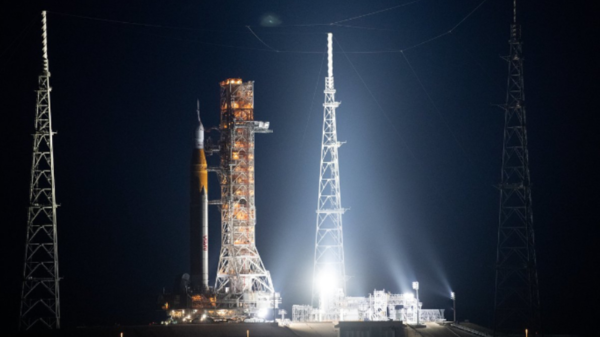The latest NASA rocket, the most powerful in the world, is scheduled to launch for the first time Monday from Florida to the moon, but NASA technical teams are having difficulty filling it with fuel, a few hours before the scheduled event.
The filling of the tanks began with a delay of about an hour, due to the high risk of lightning strikes in the middle of the night.
Operations were scheduled to last several hours until the rocket was filled with more than three million liters of hydrogen and super-cold liquid oxygen.
But around 3am local time, a possible leak was detected while filling the main layer with hydrogen, which brought operations to a temporary halt. After testing, operations have finally resumed normally, with teams on site continuing to closely monitor the situation.
NASA hopes to make up for the accumulated delay. Take off is scheduled for 08:33 am (1233 GMT) from Launch Pad 39B at the Kennedy Space Center.
The launch window is more than two hours long, which leaves room for maneuver. But while meteorological forecasts suggest that the weather will be 80% suitable if the launch is on time, the weather conditions are expected to deteriorate gradually during the morning.
The orange and white SLS rocket, which is 98 meters high, will not be able to take off in the event of rain or thunderstorms.
Half a century after the last “Apollo” flight, the “Artemis 1” mission would herald the launch of the American program to return to the moon, which is supposed to allow humanity to later reach Mars on the same craft.
The unmanned Orion capsule will be launched into orbit around the moon, to verify that the vehicle is safe to transport future astronauts, including the first woman and the first people of color to walk on the moon’s surface.
“This mission holds the dreams and hopes of many people,” NASA Administrator Bill Nelson said last weekend. “Now we are the Artemis generation.”
In a sign of the changes taking place, NASA’s first director of launch operations, Charlie Blackwell Thompson, will give the final “go” signal. Women represent 30% of the workforce in the launch rooms, after their number was limited to one woman on the “Apollo 11” mission.
Two minutes after liftoff, the thrusters will return to the Atlantic Ocean. After eight minutes, the main layer will separate as well. Then, about an hour and a half later, a final push into the upper layer will put the capsule on its way to the moon, taking several days to get there.
Between 100,000 and 200,000 people are expected to attend the parade, including US Vice President Kamala Harris.
In the event of cancellation, the next possible take-off date is September 2nd.
The mission mainly aims to test the capsule’s heat shield, which will return to the Earth’s atmosphere at a speed of 40,000 kilometers per hour, and a temperature equivalent to half the temperature of the sun’s surface.
Instead of astronauts, the spacecraft carries stereoscopic displays, which are equipped with sensors that record vibrations and radiation levels. Small satellites will also be deployed to study the moon or even an asteroid.
The capsule will reach 64,000 km beyond the moon, farther than any other spacecraft capable of transporting humans to date. Several (after Congress ordered this mission in 2010 with an initial take-off date in 2017).
For her part, NASA Associate Administrator Bhavya Lal said, “What we’re starting with this launch Monday is not a short-term race, but a long-term marathon, to bring the solar system and beyond into our domain.”
After this first mission, “Artemis 2” will transport astronauts to the moon in 2024, without landing on its surface. The first landing of a manned mission will happen to the crew of “Artemis 3” in 2025 at the earliest. NASA seeks to launch one mission annually thereafter.
The goal is to establish a permanent human presence on the moon, with the establishment of an orbiting space station (“gateway”) and a base on its surface.
There, humanity will learn to live in deep space and develop all the technologies needed to make round trips to Mars.
Such a trip takes several years, and may take place “at the end of the 1930s,” according to Bill Nelson.
But before that, going to the moon is also strategic, as it counters the ambitions of competing nations, particularly China.
“We want to go to the south pole (of the moon), where the resources are,” Nelson said on NBC, “especially water in the form of ice.”
“We don’t want China to go there and say ‘This is our land’,” he said.

